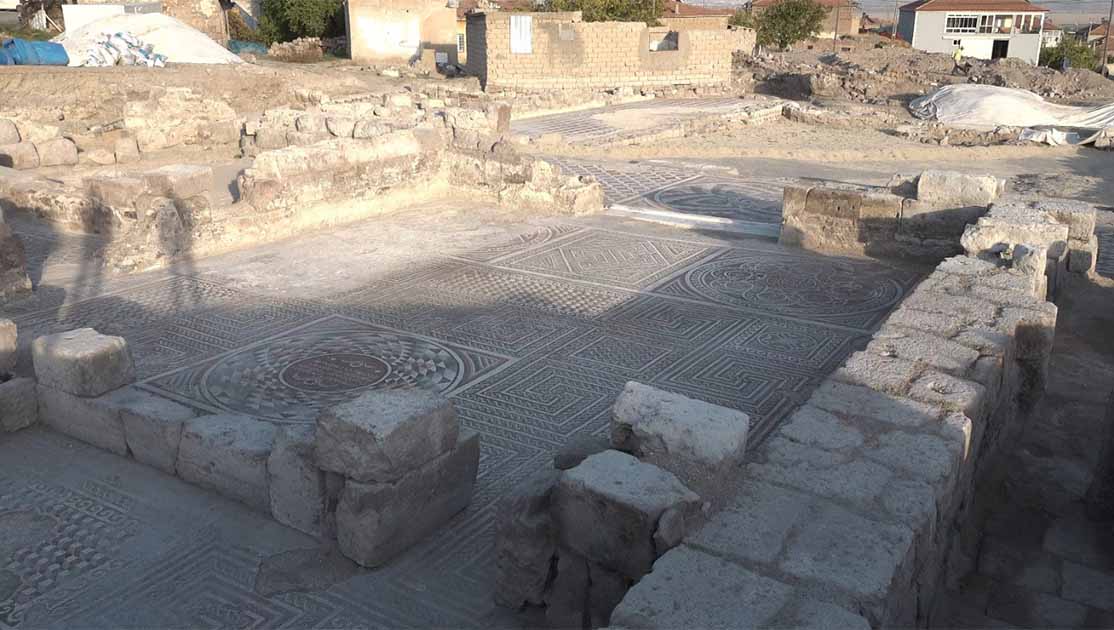Vast and Mesmerizing Floor Mosaic Unearthed in Cappadocian Villa
A floor mosaic covering a whopping area of 600 square meters has been uncovered during excavations in Cappadocia, in the heart of Turkey. Ongoing excavations at the site, believed to be the remnants of a villa dating back to the 4th century, have revealed it to have been utilized during the Byzantine period and again used following the arrival of the Turks to Anatolia. The latest mosaic is the largest ever found in the region, and is one in a continuum of mosaic discoveries.
Double the Effort, Double the Floor Area: Excavation Diaries
The excavation efforts are being conducted under the guidance of Dr. Can Erpek, a lecturer in the Department of Art History at Nevşehir Hacı Bektaş Veli University. The excavation director, Can Erpek, explained that the site comprises approximately 33 rooms spread over a vast area, constituting a high-level residence. The full boundaries of this residence have not yet been reached, and it features highly valuable floor mosaics, reports Milliyet.
The mosaics came to light initially during salvage archaeology operations in 2010. Subsequent excavations in 2010 and 2012 partially revealed the mosaic inscriptions. Due to legal issues, however, the archaeological work faced suspension. The resumption of excavations in 2020 marked a significant development.
By the conclusion of the 2021 season, over 10 rooms with approximately 300 square meters (3230 square feet) of impeccably preserved mosaic floors had been unveiled. This has now been expanded to 600 square meters (6460 sq feet). The doubled floor area contributes to the broader exploration of the site, which has seen a total of 4,000 meters (roughly 43,000 square feet) excavated thus far.
In the Central Anatolia Region, encompassing the Cappadocia region, a residence of such size with floor mosaics is not often found, although imperial properties are well-known from the Roman and Byzantine periods.
This site bears the name 'Hyacinthos' in its inscriptions. It is believed that this name belonged to an administrator. As the data becomes clearer, it is anticipated that the residence belonged to an important figure serving in imperial property.
- The Ancient City of Kibyra and its Stellar Rise to Power
- Ancient Underground City Found Hidden in Turkey's Trabzon Province
According to Şükrü Dursun, the Kayseri Provincial Director of Culture and Tourism, the excavation which commenced three years ago has been an ongoing endeavor, with the added caveat that "the structure is expanding every year."

The extensive mosaic floored house at Cappadocia, Turkey. (Kayseri Municipality)
A Grand Villa, Intricate Mosaics and Craftsmanship
Dursun explained according to the statement from the Kayseri Municipality:
“In our assessments, we have come to the conclusion that this place was built in the 4th century. According to the findings, there are also traces dating back to the 3rd century and beyond. The quality craftsmanship used in the floor mosaics suggests that this place was used as a very important villa in its era.”
The central reception hall, along with its adjacent rooms, showcases an extensive collection of floor mosaics. These mosaics feature intricate geometric patterns that collectively create a visually stunning wall-to-wall carpet effect.
“In the area identified as the reception hall, a Latin inscription was found. In addition to that, Greek inscriptions were also uncovered. Geometrically decorated mosaics are predominantly present here. We have reached the end of our excavations for this year. Hopefully, our work will continue next year,” added Dursun.
The reception hall mosaics carry fascinating symbols and motifs: various patterns such as simple guilloche, characterized by two interlaced strand lines, and chain guilloche, where the interlaced strands are linked together in a chain-like fashion. Among the intricate designs are 3D cubes, Solomon's knots, wave bands, meanders, ribbons, diamonds, swirls, amongst other elements.
- The Lost and Coveted Treasures of King Solomon
- Researchers Find Roman Villas and a Spectacular Mosaic in Egypt

A close up of one of the symmetrical patterns of the floor mosaics at the site. (Kayseri Municipality)
Within the main room, a shield of triangles takes center stage, a feature reminiscent of earlier mosaics where such shields often surrounded depictions of the gorgon Medusa. This shield encompasses a Latin inscription that offers praise to the very building itself.
When in Anatolia: A Lavish History of Mosaics
The Anatolian region boasts a diverse array of floor mosaics across various ancient civilizations. Throughout its expansive history, Anatolia has been home to a multitude of cultures and the floor mosaics reflect this rich diversity, showcasing distinctive styles and cultural influences from the Roman, Byzantine, and Ottoman eras.
Themes and subjects depicted in Anatolian floor mosaics are wide-ranging, encompassing geometric patterns, intricate floral designs, mythological scenes, and glimpses into daily life. Religious themes, often featuring Christian symbolism, are prevalent, especially in mosaics from the Byzantine period. These artworks serve as visual narratives, illustrating the beliefs, customs, and artistic preferences of the people who inhabited Anatolia across different historical periods.
Top image: Extensive floor mosaics uncovered at the site at İncesu, Cappadocia. Source: Kayseri Municipality
By Sahir Pandey
References
Aydin, S. 2023. In the mosaic excavation work in Kayseri, the size of the area increased to 600 square meters. Available at: https://www.milliyet.com.tr/gundem/kayseride-mozaik-kazi-calismasinda-alanin-buyuklugu-600-metrekareye-cikti-7032935.
Bureau, A. 2023. The Largest Ancient Floor Mosaic with Greek Inscriptions Uncovered in Cappadocia – 600 square metres. Available at: https://greekcitytimes.com/2023/11/14/ancient-floor-mosaic-in-cappadocia/.
Kayra, O. 2023. The Largest Ancient Floor Mosaic in Cappadocia and Central Anatolia Region Uncovered -600 square meters-. Available at: https://arkeonews.net/the-largest-floor-mosaic-in-cappadocia-and-central-anatolia-region-uncovered-600-square-meters/.
Milligan, M. 2023. LARGE MOSAICS UNEARTHED AT ANCIENT SADOGORA. Available at: https://www.heritagedaily.com/2023/11/large-mosaics-unearthed-at-ancient-sadogora/149220.

















